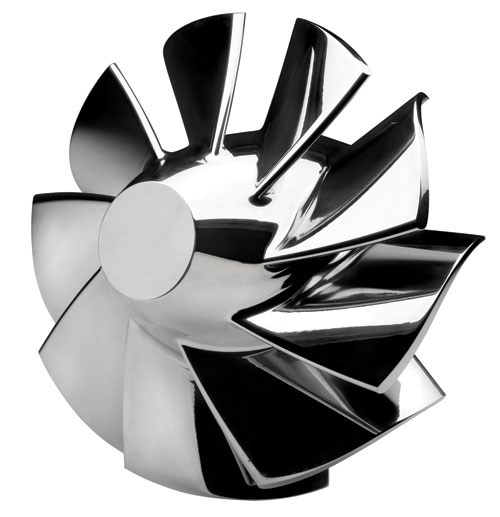Multi-Tasking in Moldmaking
How and when to best apply multi-task machining and a look at the importance of the right programming system for these machines as well as considerations when reviewing your in-house programming software.
Manufacturing is no island. Business is global. These last few years have definitely taught us that. With manufacturers facing fierce competition, producing a quality part in a shorter timeframe, all at a lesser cost is the promised-land we’re all trying to reach. So how do you get there? To some, it is like a remote island hidden somewhere across a turbulent ocean with only a broken paddle to help. To others, it is in plain sight—an achievable feat—albeit with some assistance from new technology.
Multi-tasking is one technology that has been around for a while, but has only recently become the hot topic as more shops discover their uses. In fact, many companies who previously never thought about getting a multi-task machine have done so or are thinking about doing it for the gains in productivity they offer.
“We wanted to reduce and/or eliminate fixturing as much as possible,” explains Tom Moore, co-founder of Single Source Precision Machining in Indiana, whose machine also comes with an optional indexing sub-spindle. “We also wanted to produce parts with better accuracy.”
Additionally, once a new technology has been acquired, new benefits are discovered. Phil Martin, of ETBO Tool and Die in ON reports, “We have been looking for a turning and a 5-axis solution for some time, but have been conservative in our purchases through the recent market collapse. Some of our tooling requirements are better suited to larger 5-axis machines and in the past we viewed a mill-turn as more of a production machine without the ability to address our larger requirements. With new opportunities for ETBO that are well suited to mill-turning it made us reflect on how many other applications we could apply mill-turn to.“
Although any type of work can benefit, there are certainly target areas for multi-tasking: oil and energy, medical, small parts, etc. If you are doing this type of work, a multi-task machine is a valid consideration during your next budget meeting. Martin continues, “One of ETBO's focus areas is tooling for a diverse range of automotive metal stampings as well as thin metal stampings for medical and electrical markets. Through the downturn we have been more aggressive in marketing our ability to provide custom machining solutions for various industries including aerospace, medical as well as our more traditional automotive markets. With the synergies of these diverse markets […], a mill-turn machine was a perfect fit to supply our customers with the cost-effective quality solutions expected.”
The last few years have been challenging, and the parts have not gotten any easier. In fact, parts seem to be getting more and more challenging these days, perhaps due to the overwhelming use of 3-D solid model design systems allowing engineers to render, virtually test, assemble and visualize parts prior to manufacturing. Issues like design changes, aesthetics and manufacturability are all coming into play more than ever before, which combine to change processes downstream, including manufacturing. We now see lathe parts with features requiring moldmaking processes, and molds or parts where features can be more efficiently turned on a lathe or mill with turning capability. In order to keep up with challenging new geometries for parts while keeping costs low, multi-task machines are quickly becoming the go-to technology to reach that goal. Supporting this does offer some challenges.
Multi-Tasking Software Challenges
A machine like this could be considered disruptive technology— having the ability to significantly change downstream processes. One of the biggest mistakes a shop can make is not considering what might be affected and planning accordingly. In fact, many companies will look at new machine tool technology every year, and not much else to ensure maximum productivity gains.
One of the biggest challenges with a machine like this is the heightened complexity of NC programming and the importance of program verification. The concept of the machine is often misunderstood or under-utilized, and some shops struggle to make ends meet enough to justify the machine purchase or another machine. However, when the machine’s capabilities are finally realized, the machine quickly justifies itself. This is why a programming system is important for these machines.
There are a lot of things to think about, but here are six questions to ask when looking at your in-house programming software, or shopping for a new solution:
1. Does it support all the options available to the machine?
2. Does it support more complex machines/machining?
3. Does it have the front-end capability to give me the tool control needed for this machine?
4. Does it have a simulation capability that is accurate and can fully represent the machine?
5. Does it have a post processor that is already proven for this machine tool?
6. Does it program all my existing equipment at the shop?
As a manufacturing company adds new capabilities and technology, the shop shouldn’t get overburdened with implementing complex technology without the necessary supporting elements.
Whether the multitask machine is a milling machine with turning capability or a multi-spindle, multi-turret lathe, the machines are getting more complex and solutions need to support these, and future machines. We are seeing machines with sub-spindles that index and move, four turrets, multiple gang-slides and even indexing B-axis milling heads on lathes now as common. Taking all these machines into account, a programming system is going to directly relate to the productivity you receive from your machines. In the case of ETBO, they looked for a CAM solution that has a simple interface while still allowing for detailed toolpath control.
Martins explains, “With respect to mill-turn specifically, the solution we chose had a tight relationship with Mazak creating a robust post processor and good simulation of the machine model. There are two needs that stood out to ETBO for programming mill-turns. The first is machine simulation. It is much easier to have a machine crash on a mill-turn compared with 3-axis milling. The second is axis control. On a mill-turn there are often various strategies to accomplish an end product. We needed a programming system that provides robust toolpaths to utilize the axes that are applicable to the highest quality part and/or most cost-effective machining strategy.”
This programming system should support the tool control needed to generate a complete and optimized NC program up front. The program should offer the user a seamless interface for visually representing the machining processes on the computer, without having to waste valuable machine time proving programs. In this regard, the post processor should be proven, and available to be supplied with the programming solution. In the case of Single Source Precision Machining, a proven CNC-programming solution was supplied on-board the machine tool itself.
“Our machine tool can do so much,” says Moore. “To date, our new programming system has matched our multi-task machine’s every move. Receiving a programming solution from the machine builder with a reliable post processor and simulations are a great value to us. In fact, we have just recently installed our second machine, so things are going good.”
Summary
The complexity of these machines will create a many-week, several-month process of proving out NC code if this is not the case. The cost of the machine being down all this time will add up to a significant difference in cost if the machine had been cutting parts. This monetary difference would also likely exceed the entire cost to implement a new programming system, so proper care should be taken in evaluating these things for your machining requirements today, and in the future.
Related Content
What is Scientific Maintenance? Part 2
Part two of this three-part series explains specific data that toolrooms must collect, analyze and use to truly advance to a scientific maintenance culture where you can measure real data and drive decisions.
Read MoreTolerancing in Mold Design, Part 1: Understanding the Issues of Conventional Bilateral Tolerancing
Mold designers must understand the location, orientation and form limitations of conventional tolerancing before changing to another dimensioning system.
Read MoreWhat Is Scientific Maintenance? Part 1
Part one of this three-part series explains how to create a scientific maintenance plan based on a toolroom’s current data collection and usage.
Read MoreHow to Select a Mold Temperature Controller
White paper shares how cooling channel analysis, which collects maximum pressure drop, total flow rate and heat dissipation, eases the performance evaluation of mold temperature controllers.
Read MoreRead Next
Are You a Moldmaker Considering 3D Printing? Consider the 3D Printing Workshop at NPE2024
Presentations will cover 3D printing for mold tooling, material innovation, product development, bridge production and full-scale, high-volume additive manufacturing.
Read MoreReasons to Use Fiber Lasers for Mold Cleaning
Fiber lasers offer a simplicity, speed, control and portability, minimizing mold cleaning risks.
Read More






















